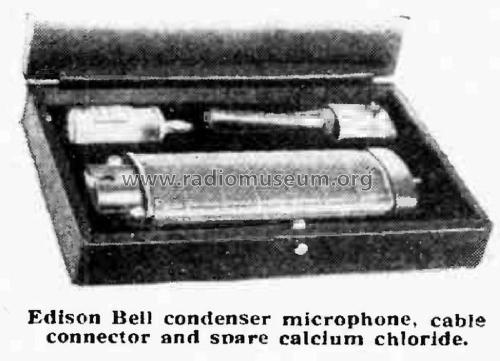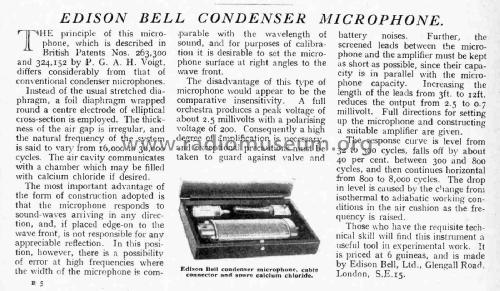Condenser Microphone.
Edison-Bell Ltd.; London
- Produttore / Marca
- Edison-Bell Ltd.; London
- Anno
- 1932
- Categoria
- Microfono o Pick-up
- Radiomuseum.org ID
- 340370
- Principio generale
- Amplificatore audio
- Gamme d'onda
- - senza
- Tensioni di funzionamento
- Alimentazione non richiesta
- Materiali
- Vari materiali
- Radiomuseum.org
- Modello: Condenser Microphone. - Edison-Bell Ltd.; London
- Forma
- Diverse forme (descritte nelle note).
- Annotazioni
-
Edison Bell Condenser Microphone.
The principle of this microphone, which is described in British Patents Nos. 263,300 and 324,152 by P. G. A. H. Voigt, differs considerably from conventional condenser microphones.
Instead of the usual stretched diaphragm, a foil diaphragm wrapped around a centre electrode of elliptical cross-section is employed. The thickness of the air gap is irregular, and the natural frequency of the system is said to vary from 16,000 to 30,000 cycles. The air cavity communicates with a chamber that may be filled with calcium chloride if desired.
The most important advantage of the form of construction adopted is that the microphone responds to soundwaves arriving in any direction, and, if placed edge onto the wavefront, is not responsible for any appreciable reflection. In this position, however, there is a possibility of error at high frequencies where the width of the microphone is cormparable with the wavelength of sound, and for purposes of calibration, it is desirable to set the microphone surface at right angles to the wavefront.
The disadvantage of this type of microphone would appear to be the comparative insensitivity. A full orchestra produces a peak voltage of about 2.5 millivolts with a polarising voltage of 200. Consequently, a high degree of amplification is necessary, and exceptional precautions must be taken to guard against valve and battery noises.
Further, the screened leads between the microphone and the amplifier must be kept as short as possible, since their capacity is in parallel with the microphone capacity.
Increasing the length of the leads from 3ft. to I2ft. reduces the output from 2.5 to 0.7 millivolt. Full directions for setting up the microphone and constructing a suitable amplifier are given.
The response curve is level from 32 to 300 cycles, falls off by about 40 percent, between 300 and 800 cycles, and then continues horizontally from 800 to 8,000 cycles. The drop in level is caused by the change from isothermal to adiabatic working conditions in the air cushion as the frequency is raised.
Those who have the requisite technical skill will find this instrument a useful tool in experimental work. It is priced at 6 guineas.
Wireless World Aug 26, 1931, Page 205.
- Bibliografia
- Wireless World (The), London (WW, 79) (Aug 26, 1931, Page 205.)
- Autore
- Modello inviato da Gary Cowans. Utilizzare "Proponi modifica" per inviare ulteriori dati.
- Altri modelli
-
In questo link sono elencati 26 modelli, di cui 14 con immagini e 4 con schemi.
Elenco delle radio e altri apparecchi della Edison-Bell Ltd.; London

